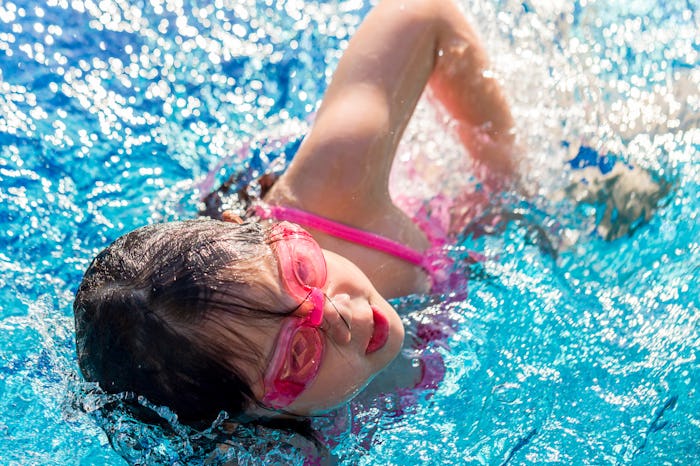Life

Dry Drowning Sounds Terrifying, So Here's What You *Really* Need To Know About It
My 5-year-old son loves to swim — he’s not afraid of waves at the beach, or jumping in the deep end at the pool out at our family farm. I love watching him because he has so much fun, and as a retired lifeguard, seeing him become more and more confident around water gives me a sense of pride. But as a former rescue professional I'm all too familiar with the questions about drowning, specifically the terror known as dry drowning. But is dry drowning real?
You know those moments when you accidentally swallow too much water and you begin to cough like you’re trying to hack up your left lung? Yeah, witnessing that with my son is enough to give me an instant panic attack. Irrational thoughts immediately begin to pour in. Should I take him to the ER just in case? Do I have to monitor him for the rest of the day? The minute he tells me that he feels sleepy, I'm sent into anxiety mode. I decided to do some research on the subject of dry drowning after watching a show called The Affair, where a main character’s young son dry drowned in his sleep after a day at the beach (talk about anxiety-inducing). There’s a lot of controversy surrounding dry drowning because some experts say it’s not plausible, but what is it exactly and what can we do to prevent it and keep our kids safe in the water?
Arizona-based pediatrician Dr. Salil Pradhan told USA Today that the phenomena of dry drowning happens when “a child inhales water through the nose or mouth, causing a spasm in the airway and difficulty breathing. The drowning is called dry because the water does not enter the lungs because of spasm (reflex closing) of the vocal chords”. When these spasms occur, it prevents air from entering the lungs, causing lack of oxygen, unconsciousness, and death.
Dr. Pradhan continued and explained that secondary drowning, often called delayed drowning, is a little different. This is “when a child inhales water into his or her lungs, causing inflammation or edema (swelling).” When this happens, the swelling takes place “hours or even days after initial contact with water."
But how much of dry drowning is actually real? Is it as common as everyone thinks? Pediatric nurse Dani Stringer of Kid Nurse explained on her website that “dry drowning is not an accepted medical condition. Neither is near drowning or secondary-drowning”. Stringer argues that drowning is drowning and even in submerged drowning cases, very little water is found in the lungs. She assures parents that while not accepted medical terms, these types of delayed drownings are very rare, with clear and worsening symptoms presenting themselves immediately after an episode, making it very difficult for parents to miss.
Stringer further explained the symptoms you need to be looking for are "coughing, wheezing, inability to catch their breath, vomiting, extreme fatigue and disorientation”. Dr. Seth Hawkins discussed these symptoms in a reviewed article with Emergency Medical News and said, “people who have drowned and have minimal symptoms will either get better or worse within two to three hours." The bottom line? You will know whether or not there is something wrong with your child after a water incident, but there are steps you can take to help ensure that you keep your kids safe.
No matter how great of a swimmer your child is, you'll want to communicate firm rules revolving around water safety. Do not let your child go near the water unsupervised, encourage them not to run in areas that may be slippery and surrounded by water, and always make sure your toddler is within arms reach whenever near the water. Be sure to teach your kids to swim when they’re ready, too. A lot of kids, including my own, are afraid to put their face in the water. That’s OK, but it is important for them to learn to blow bubbles or hum their favorite song while their mouth is in the water, as this helps them learn to exhale underwater, noted Stringer.
She also suggested opting for a Coast Guard approved swim vest instead of inflatable orange arm swimmies, as these can create a “false sense of confidence” around the water. As a former swimmer and lifeguard, I believe arm swimmies are less helpful in teaching children how to swim because they're not given enough range in motion to learn the appropriate movements. And lastly, it’s always a good idea to learn CPR and make sure your child is swimming with adults who know child CPR.
While “dry drowning” isn’t an accepted medical term, the condition is very rare and drowning is possible without being submerged underwater. It’s best to always exercise caution around the water, but don't be afraid you will miss drowning symptoms as they're difficult to overlook. Your child will not play in the water, cough a little, and then all of a sudden drown hours or days later. So go ahead and enjoy a cool down at the pool this summer while making memories with your kiddos.